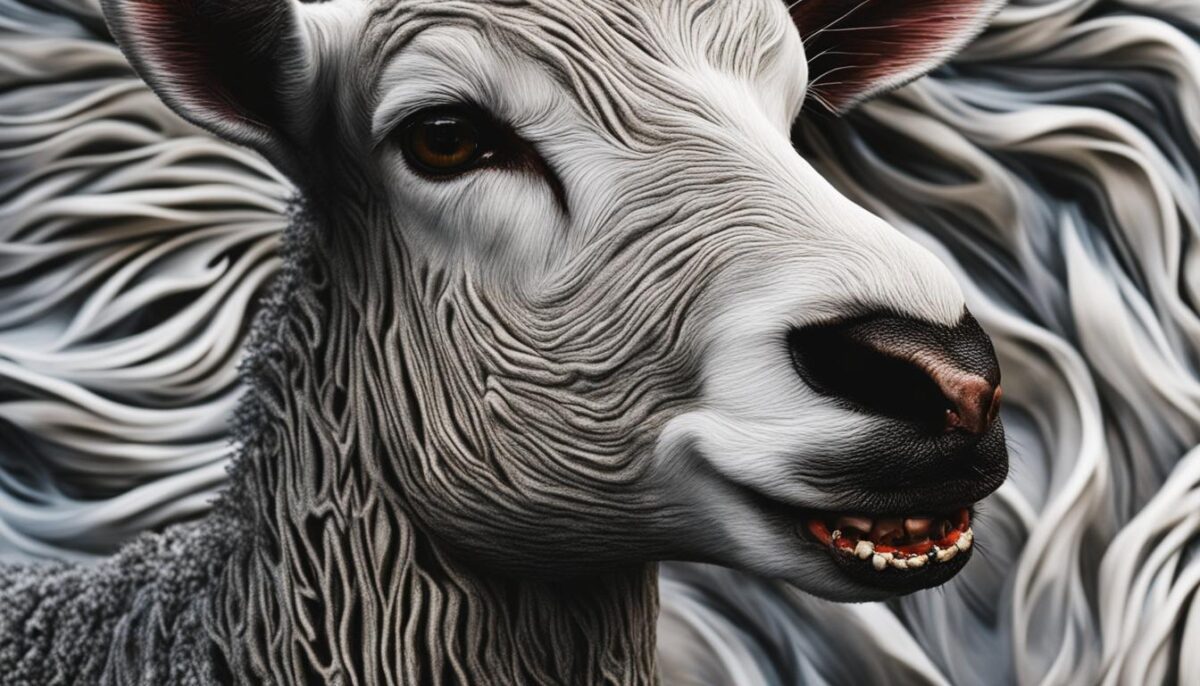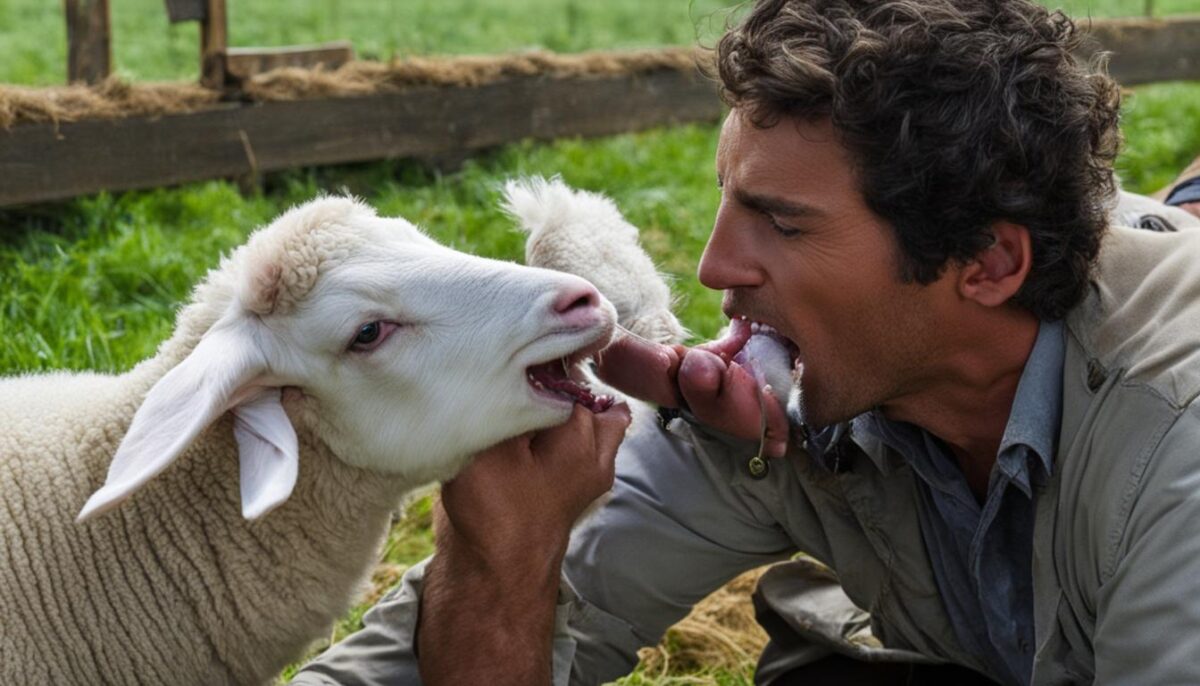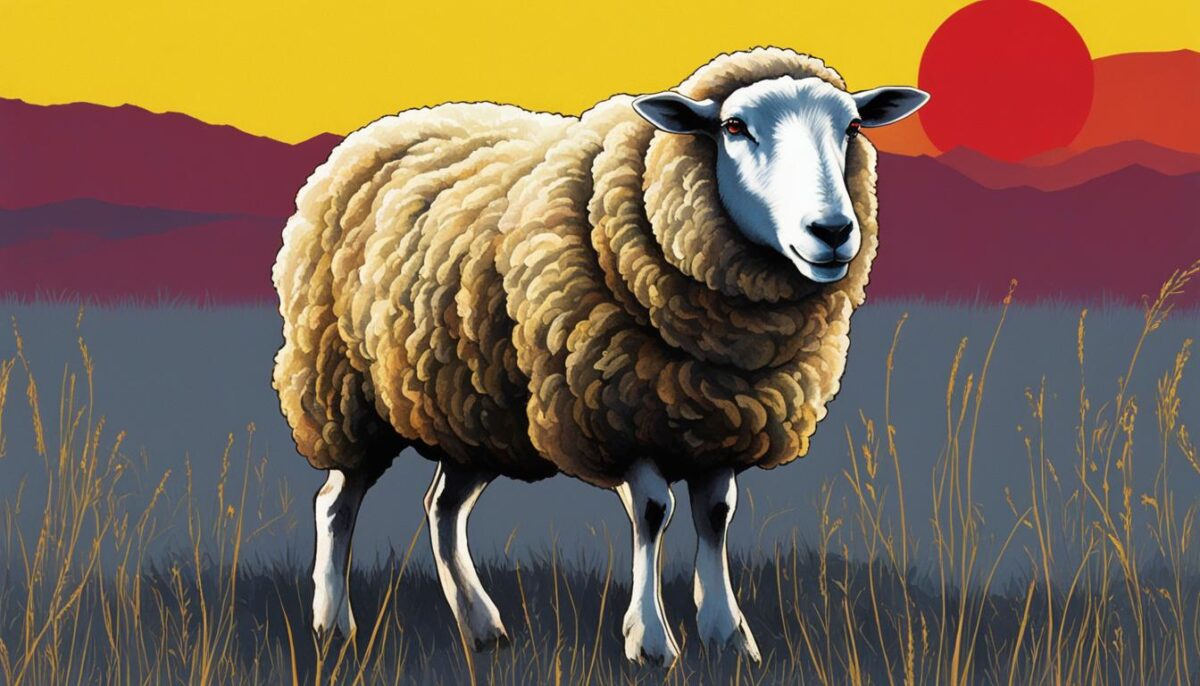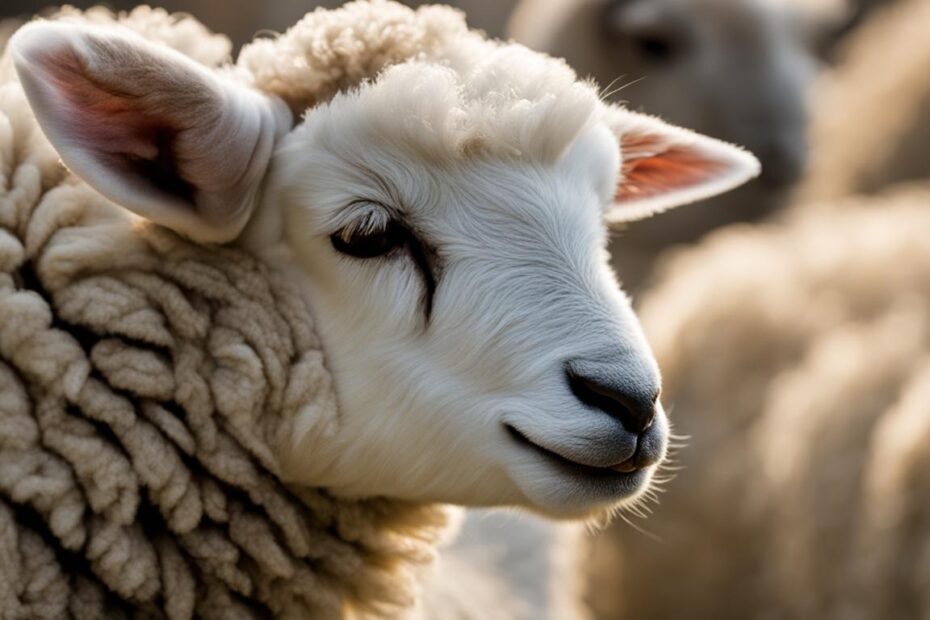Grinding of teeth in lambs is a sign of pain or discomfort. It is important to identify the causes of tooth grinding and provide appropriate care to ensure the well-being of your lamb.
In this article, we will explore common causes of tooth grinding in lambs, the connection between stress and teeth grinding, and how to reduce stress to prevent this behavior.
Key Takeaways:
- Lambs grinding their teeth may be experiencing pain or discomfort.
- Common causes of tooth grinding in lambs include hoof injuries, mastitis, tail-docking, castration, and mulesing.
- Stress, both physical and environmental, can contribute to tooth grinding in lambs.
- Reducing stress through proper nutrition, clean water, parasite control, and gentle handling is essential.
- Pain management in lambs involves identifying behavioral and physiological indicators of pain.
Common Causes of Tooth Grinding in Lambs
Lambs may grind their teeth due to various reasons, including hoof injuries, mastitis (infections in the udder), tail-docking, castration, and mulesing (cutting wool-bearing and wrinkled skin). These practices may cause pain and discomfort in lambs.
Hoof injuries, such as cuts or bruises, can result in lameness and tooth grinding. Inadequate hoof care and sharp objects in the environment can contribute to these injuries. Regular hoof trimming and maintaining a clean and safe environment can help prevent hoof-related problems and reduce the risk of tooth grinding in lambs.
Mastitis, characterized by inflammation and infection of the udder, can cause pain and discomfort in lactating ewes, which may lead to tooth grinding in lambs during nursing. Proper udder hygiene, regular milking, and prompt treatment of any signs of mastitis can help prevent its occurrence and reduce the likelihood of tooth grinding in lambs.
Table: Common Causes of Tooth Grinding in Lambs
| Cause | Description |
|---|---|
| Hoof Injuries | Injuries to the hooves, such as cuts or bruises, can cause lameness and tooth grinding. |
| Mastitis | Infections in the udder can cause pain in lactating ewes, leading to tooth grinding in lambs during nursing. |
| Tail-Docking | Removal of the tail can cause discomfort and pain, resulting in tooth grinding. |
| Castration | Surgical removal of the testicles can cause pain and discomfort, leading to tooth grinding. |
| Mulesing | Cutting wool-bearing and wrinkled skin can cause pain and distress in lambs, resulting in tooth grinding. |
Tail-docking, the removal of the tail, is a common husbandry practice in lambs to reduce the risk of flystrike and improve hygiene. However, this procedure can cause discomfort and pain, leading to tooth grinding. Implementing pain management strategies during tail-docking, such as using analgesics or providing local anesthesia, can help minimize the pain experienced by lambs and reduce the occurrence of tooth grinding.
Castration, the surgical removal of the testicles, can also cause pain and discomfort in lambs. Pain relief measures, such as using analgesics or performing castration at a young age when lambs are more resilient, can help mitigate the pain associated with castration and decrease the likelihood of tooth grinding.
Mulesing, a procedure performed to reduce the risk of flystrike, involves the removal of skin folds around the breech area. This practice can cause pain and distress in lambs, leading to tooth grinding. Exploring alternative methods, such as genetic selection for breech strike resistance or using pain relief strategies during mulesing, can help minimize the pain and discomfort experienced by lambs and reduce tooth grinding incidents.
The Connection Between Stress and Tooth Grinding in Lambs
Stress can have a significant impact on the oral health of lambs, leading to tooth grinding. Lambs are sensitive creatures, and both physical and environmental stressors can disrupt their routine and environment, causing discomfort and dental issues. Understanding and minimizing stressors are crucial for maintaining the well-being of lambs.
Nutritional stress is one common factor that can contribute to tooth grinding in lambs. When lambs do not receive adequate nutrition or their diet is imbalanced, it can result in stress and discomfort, leading to teeth grinding. Providing proper nutrition and ensuring that lambs have access to clean water and a balanced diet can help alleviate this type of stress.
Shearing stress is another significant factor that can contribute to tooth grinding in lambs. The shearing process can be stressful for lambs, especially if it is not handled correctly or if they are restrained improperly. This stress can cause discomfort and lead to teeth grinding. It is essential to ensure that shearing procedures are performed gently and with minimal stress to reduce the chances of tooth grinding.
By understanding the connection between stress and tooth grinding in lambs, farmers and caretakers can take proactive steps to minimize stress and support the oral health of these animals. Providing a stress-free environment, proper nutrition, and gentle handling can go a long way in preventing tooth grinding and promoting the overall well-being of lambs.

Table: Factors Contributing to Stress and Tooth Grinding in Lambs
| Factor | Description |
|---|---|
| Nutritional stress | Inadequate or imbalanced diet leading to stress and discomfort |
| Shearing stress | Stress caused by improper shearing procedures and handling |
Understanding these factors can help farmers implement appropriate measures to reduce stress in lambs and prevent tooth grinding. By providing a nurturing environment and addressing the underlying causes of stress, lambs can enjoy better oral health and overall well-being.
How to Reduce Stress in Lambs and Prevent Tooth Grinding
Reducing stress in lambs is crucial for their overall well-being and can help prevent tooth grinding. By providing the right nutritional requirements, clean water, parasite control, and proper handling during pregnancy, you can create a healthier and more relaxed environment for your lambs.
Nutritional Requirements
Proper nutrition is essential for lambs to thrive and maintain good oral health. Ensure that your lambs have access to high-quality forage or pasture, as well as a balanced diet that meets their specific nutritional needs. Consult with a veterinarian or a livestock nutritionist to develop a feeding plan that provides the right balance of proteins, carbohydrates, vitamins, and minerals.
Clean Water
In addition to proper nutrition, lambs also need access to clean and fresh water at all times. Water plays a critical role in digestion, temperature regulation, and overall health. Make sure to regularly check and clean water troughs or containers to prevent the buildup of bacteria or contaminants that could affect your lambs’ well-being.
Parasite Control
Parasites can cause significant stress and discomfort in lambs, leading to tooth grinding and other health issues. Implement an effective parasite control program that includes regular deworming and monitoring for parasites such as worms, lice, and ticks. Consult with a veterinarian to determine the most appropriate deworming schedule and products for your lambs.
Handling During Pregnancy
Proper handling during pregnancy is crucial to reduce stress in both the pregnant ewes and their unborn lambs. Avoid unnecessary movements or disturbances that could cause anxiety or harm to the pregnant ewes, as this can have a negative impact on the lambs’ development and well-being. Provide a calm and quiet environment for the pregnant ewes, minimizing sudden noises or disruptive activities.
By implementing these practices, you can create a stress-free environment for your lambs, reducing the likelihood of tooth grinding and promoting their overall oral health. Remember to consult with a veterinarian or livestock specialist for personalized advice and guidance specific to your flock’s needs.
Pain Management in Lambs
Pain management is crucial for the well-being of lambs. It is essential to assess and address any pain or discomfort they may be experiencing. Recognizing the signs of pain in lambs is the first step towards effective pain management. Pain assessment can be done through behavioral and physiological indicators.
Behavioral Indicators
Lambs in pain may exhibit various behavioral changes that can indicate their discomfort. These include reduced feed intake, licking or rubbing painful areas, reluctance to move, and teeth grinding. Observing these behaviors can help identify pain and take appropriate action.
Physiological Indicators
In addition to behavioral indicators, physiological changes can also indicate pain in lambs. Hyperalgesia, or an increased pain response, can be a physiological indicator. Measuring cortisol levels, which are elevated in response to stress and pain, can also provide insight into a lamb’s pain levels.
By assessing both behavioral and physiological indicators of pain, veterinarians and farmers can gain a comprehensive understanding of a lamb’s discomfort. This allows for targeted pain management strategies to be implemented.
| Pain Assessment | Behavioral Indicators | Physiological Indicators |
|---|---|---|
| Lameness Scoring | Reluctance to move | N/A |
| Facial Expression Scoring | Licking or rubbing painful areas | Hyperalgesia |
| Sheep Pain Facial Expression Scale (SPFE) | Teeth grinding | Cortisol levels |
Implementing appropriate pain management techniques based on pain assessment results can significantly improve the well-being of lambs. This includes providing analgesic medications, adjusting husbandry practices, and considering alternative pain management strategies such as acupuncture or physical therapy. The goal is to minimize pain and promote a comfortable and healthy life for lambs.

Facial expression scoring involves observing the lamb’s facial expressions and assigning scores based on predefined indicators of pain. The SPFE provides a standardized scoring system that includes specific facial features, such as ear position, eye opening, and whisker tension. By analyzing these facial expressions, farmers and veterinarians can accurately assess the level of pain in lambs.
Lameness scoring, on the other hand, focuses on evaluating the lamb’s gait and mobility. Lambs in pain may exhibit abnormal movements or limping, indicating discomfort. By carefully observing the lamb’s movement and assigning scores based on the severity of lameness, farmers can assess the level of pain and take appropriate measures for treatment.
Once the pain level has been assessed, appropriate treatment can be provided. This may include administering analgesic medications, providing supportive care, and addressing any underlying causes of pain. It is essential to consult with a veterinarian for an accurate diagnosis and to develop a tailored treatment plan for each lamb.
Table: Comparison of Facial Expression Scoring and Lameness Scoring
| Scoring Method | Indicators | Benefits |
|---|---|---|
| Facial Expression Scoring | Ear position, eye opening, whisker tension | – Objective assessment of pain – Easy to perform – Standardized scoring system |
| Lameness Scoring | Gait and mobility | – Evaluates lameness and mobility – Helps identify lambs in pain – Enables targeted treatment |
Assessing and treating pain in lambs is not only important for their immediate well-being but also for their long-term health. By effectively managing pain, farmers can ensure the comfort and welfare of their lambs, promoting their growth and development.
Managing Metabolic Diseases in Sheep
Frequent tooth grinding in lambs can be a sign of underlying health issues, including metabolic diseases. It is crucial for sheep farmers to be aware of these conditions to ensure the well-being of their flock. In this section, we will explore the common metabolic diseases that can lead to tooth grinding in lambs and discuss the essential steps for managing them.
Twin lamb disease, also known as pregnancy toxemia, is a metabolic disorder that primarily affects ewes carrying multiple lambs. It occurs during late pregnancy when the demand for energy exceeds the ewe’s ability to intake and utilize it. As a result, the ewe’s body breaks down fat, leading to the accumulation of ketones in the blood. This condition can cause lambs to grind their teeth as they experience discomfort and pain.
| Metabolic Disease | Cause | Symptoms |
|---|---|---|
| Twin Lamb Disease | Limited energy intake, high energy demand | Weight loss, weakness, lethargy, tooth grinding |
| Milk Fever | Calcium deficiency | Muscle tremors, weak or paralyzed hind legs, tooth grinding |
| Tetany | Magnesium deficiency | Muscle spasms, convulsions, teeth grinding |
Milk fever, also known as hypocalcemia, occurs when a ewe experiences a sudden drop in blood calcium levels after giving birth. This condition can lead to muscle tremors, weakness, and tooth grinding in lambs. It is vital to provide proper calcium supplementation to prevent milk fever and its associated symptoms.
Tetany is a metabolic disorder caused by low blood magnesium levels. It can occur in lactating ewes or lambs consuming magnesium-deficient forage. Tetany can result in muscle spasms, convulsions, and tooth grinding in lambs. Ensuring an adequate supply of magnesium through proper nutrition is essential in preventing this condition.
Managing metabolic diseases in sheep requires a comprehensive approach. Providing a balanced diet, monitoring the overall health of the flock, and addressing any nutritional deficiencies are key steps in preventing these conditions. Regular veterinary check-ups and early intervention can help in managing metabolic diseases effectively and minimizing tooth grinding in lambs.

Importance of Sheep Handling and Care
Proper sheep handling and care are essential for ensuring the well-being and health of these animals. Understanding sheep behavior, designing facilities that minimize stress, reducing noise levels, and implementing gentle handling techniques are crucial factors to consider. By prioritizing these aspects, you can create a positive environment for your sheep and reduce the likelihood of tooth grinding.
Understanding Sheep Behavior
Sheep have unique behavioral patterns that require careful consideration. They have a natural flight zone, which is an area around them that they perceive as a threat. By understanding this flight zone and respecting the boundaries, you can establish a sense of trust and reduce stress during handling.
Additionally, sheep are sensitive to noise levels. Loud noises can startle and agitate them, leading to increased stress and potential tooth grinding. Therefore, it is crucial to minimize noise within the sheep facility by using sound-absorbing materials and implementing noise reduction measures.
Facility Design and Handling Techniques
The design of the sheep facility plays a vital role in reducing stress levels. Consider implementing an efficient layout that allows for easy movement of sheep, reduces handling times, and minimizes the risk of injuries. Furthermore, providing adequate lighting and ventilation can contribute to a comfortable environment.
Gentle handling techniques are essential for maintaining the well-being of sheep. Avoid sudden movements, loud voices, and aggressive handling, as these can escalate stress levels and potentially lead to tooth grinding. Instead, handle sheep calmly, using techniques that promote trust and cooperation.
| Benefits of Proper Sheep Handling and Care | Actions for Effective Sheep Handling and Care |
|---|---|
| Reduced stress levels | Implement gentle handling techniques |
| Prevention of tooth grinding | Minimize noise levels in the facility |
| Improved overall well-being | Understand sheep behavior and flight zone |
Conclusion
Taking care of a lamb’s oral health is essential for maintaining their overall well-being. By identifying the causes of tooth grinding in lambs, managing stress, and implementing proper care practices, you can prevent dental issues and ensure a healthy and happy lamb.
Regular veterinary check-ups and ongoing monitoring are crucial for maintaining excellent oral health in lambs. These check-ups allow for early detection of any dental problems and prompt treatment, ensuring that your lamb stays pain-free and healthy.
Remember to prioritize lamb oral health by providing a nutritious diet, clean water, and adequate parasite control. Additionally, handle the lambs gently, minimize stressors, and maintain a calm environment to reduce the likelihood of teeth grinding.
By following these guidelines and maintaining a proactive approach to lamb oral health, you can effectively manage tooth grinding in lambs and prevent dental issues. Your efforts will contribute to the overall happiness and well-being of your lambs, ensuring they grow into healthy adult sheep.
FAQ
What causes tooth grinding in lambs?
Tooth grinding in lambs can be caused by various factors, including hoof injuries, mastitis, tail-docking, castration, and mulesing.
How does stress contribute to tooth grinding in lambs?
Stress, both physical and environmental, can lead to tooth grinding in lambs. Factors like nutritional stress and shearing stress can disrupt their routine and environment, causing them to grind their teeth.
How can I reduce stress in lambs and prevent tooth grinding?
To reduce stress in lambs, it is important to provide appropriate nutrition, clean water, and proper parasite control. Additionally, handling the lambs gently during pregnancy and minimizing unnecessary movements can help prevent tooth grinding.
What are the indicators of pain in lambs?
Lambs in pain may exhibit reduced feed intake, licking or rubbing painful areas, reluctance to move, and teeth grinding. Pain can also be assessed through physiological indicators like hyperalgesia and cortisol levels.
How can pain in lambs be assessed and treated?
Pain in lambs can be assessed through tools like facial expression scoring and lameness scoring. The sheep pain facial expression scale is a reliable method for assessing pain in sheep, including lambs. Effective treatment can then be provided based on the severity of pain.
What are the common metabolic diseases that can cause tooth grinding in lambs?
Metabolic diseases like twin lamb disease, milk fever, and tetany can impact sheep health and cause tooth grinding. Proper nutrition, calcium supplementation, and regular health monitoring are crucial for managing these diseases and preventing tooth grinding.
How important is sheep handling and care in preventing tooth grinding?
Understanding sheep behavior and implementing proper handling techniques are essential for reducing stress and preventing tooth grinding. Designing facilities to minimize stress and handling sheep gently, while reducing noise, contribute to their overall well-being.
What should I do to take care of a lamb’s oral health?
Taking care of a lamb’s oral health involves identifying the causes of tooth grinding, managing stress, and implementing proper care practices. It is also important to schedule regular veterinary check-ups and ongoing monitoring to maintain excellent oral health in lambs.


